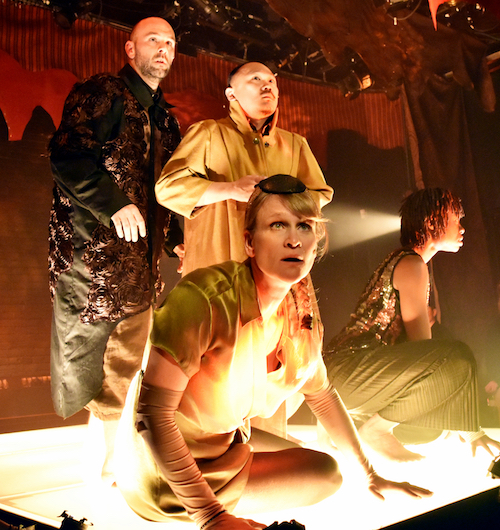 Luminato presents an apocalyptic animal cabaret, and metaphor for climate change, in Toronto
Luminato presents an apocalyptic animal cabaret, and metaphor for climate change, in Toronto
Conceived by Martha Ross (book), John Millard (music) and Tomson Highway (lyrics), and directed by Adam Paolozza, The Cave, presented by The Cave Collective as part of the 2019 Luminato Festival, envisions a sort of apocalyptic animal cabaret. A forest fire has spurred animals of all stripes and spots to seek haven in Bear’s cave; as the flames and smoke encroach ever closer, each animal tells its story, punctuated by Millard’s wry narration.
With an interesting mix of Christian theology (Adam and Eve being thoroughly dismissed from the Garden of Eden), Cree language, and an environmentalist message, the show presents numerous breathtaking song showpieces while not entirely coalescing. It’s a memorable conflagration, burning hot and brightly and then leaving in a billow of smoke.
Ushered in from the holding bar area, the audience enters the cave, a dark, almost womb-like space filled with draped fabric and musicians wearing animal accoutrements. A raised central stage is bordered by the musicians on one side and premium table seating on the other, and a wall of more traditional theatre seating to the back.
John Millard, our emcee, plays a banjo in formal short-panted schoolboy attire, playing up a droll nerd personality – one practically anticipates him declaring “I’m a PC,” John Hodgman-style – in a way you may find either endearing or irritating. I found Millard to be charming; he plays well, his compositions catchy and harmonically captivating. Oddly, though, he seems a little overwhelmed by his narrative duties, occasionally stalling while speaking; it was unclear if he was still on book or not.
The impressive musical ensemble alternately blends into the background and gets in on the fun; in particular, near the beginning, percussionist Germaine Liu slowly brings us into the drama by effectively creating a fire soundscape with gradually looped foley effects.
The music, as a whole, is the standout attraction; though starting with the expected Weimar-esque cabaret number, the show gives each animal a distinctive personality through musical style. Four performers in superb voice effectively inhabit the different creatures solo, also coming together with lovely, layered choruses. Standouts include the gentle humour of a depressed “skunk in a funk” played by Alex Samaras, a world-weary moose given very impressive vocal range by vocal powerhouse Neema Bickersteth, the heartbreaking farewell of a snake mother (Andrea Koziol) to her multiple babies with names starting with “s,” and a busy beaver’s (Derek Kwan) denial of the world around him burning as he builds.
The actors are assisted by stylish costumes (Allie Marshall) that aren’t creature suits, but contain creatively suggestive animal elements that sprout from human attire and promote clear physical movement for each character. There are steampunk-type goggles for Mouse, carved paddles or walking sticks to be the arms of Moose, a feathered wing-cape for Crow, and a web-like skirt draped over Spider.
The lyrics to the songs are variable; Highway gives himself a tough tightrope to walk, trying to remain clever while believably animalistic in character, and succeeds more often than not. Some words are playful, some instructive, such as the lessons in Cree vocabulary and grammar, and some feature gorgeous imagery, such as a love song of a crow to a fox. Others are more pedestrian – “escaping the ire of the fire,” for example – and sometimes the rhymes seemed present but meandering, almost on a delay.
The show is least effective when it hits the metaphorical nail on the head; it’s very clear that the forest fire is a metaphor for environmental destruction and climate change, and it works better when the writers trust the audience to understand that without telling them. This happens occasionally, such as in Millard’s dog number, otherwise a showstopper, that suddenly takes a turn from much more dog-like complaints about lack of human attention to a rant about humanity’s geopolitical greed that required a much steeper suspension of disbelief.
There’s a lot to love about The Cave. All told, however, something about it just didn’t quite click for me. Perhaps it was the tonal shifts, or the ending, an almost-but-not-quite-callback to an earlier plot thread that could have either been more clearly connected or presented more distinctly. The experience is worth it for the singing and aesthetic alone, though, so I’m glad it’s being livestreamed so more people can share in the experience. After all, when it comes to the apocalypse, we’re all in this together.
Details:
- The Cave plays at the Tank House Theatre (50 Tank House Lane) until June 23, 2019.
- Shows run Wednesday-Saturday at 8:00PM, with Saturday-Sunday matinees at 2:00PM.
- Tickets are $20-55 and can be purchased online, by calling 416-368-4849, or at the Festival Box Office.
- The show runs 75 minutes with no intermission.
- Audience advisory: large amounts of hazer and fog are used on stage
- The Cave will be livestreamed on June 22nd at 2:00PM and 8:00PM.
Photo of Alex Samaras, Derek Kwan, Neema Bickersteth and Andrea Koziol by Delal Hagos
